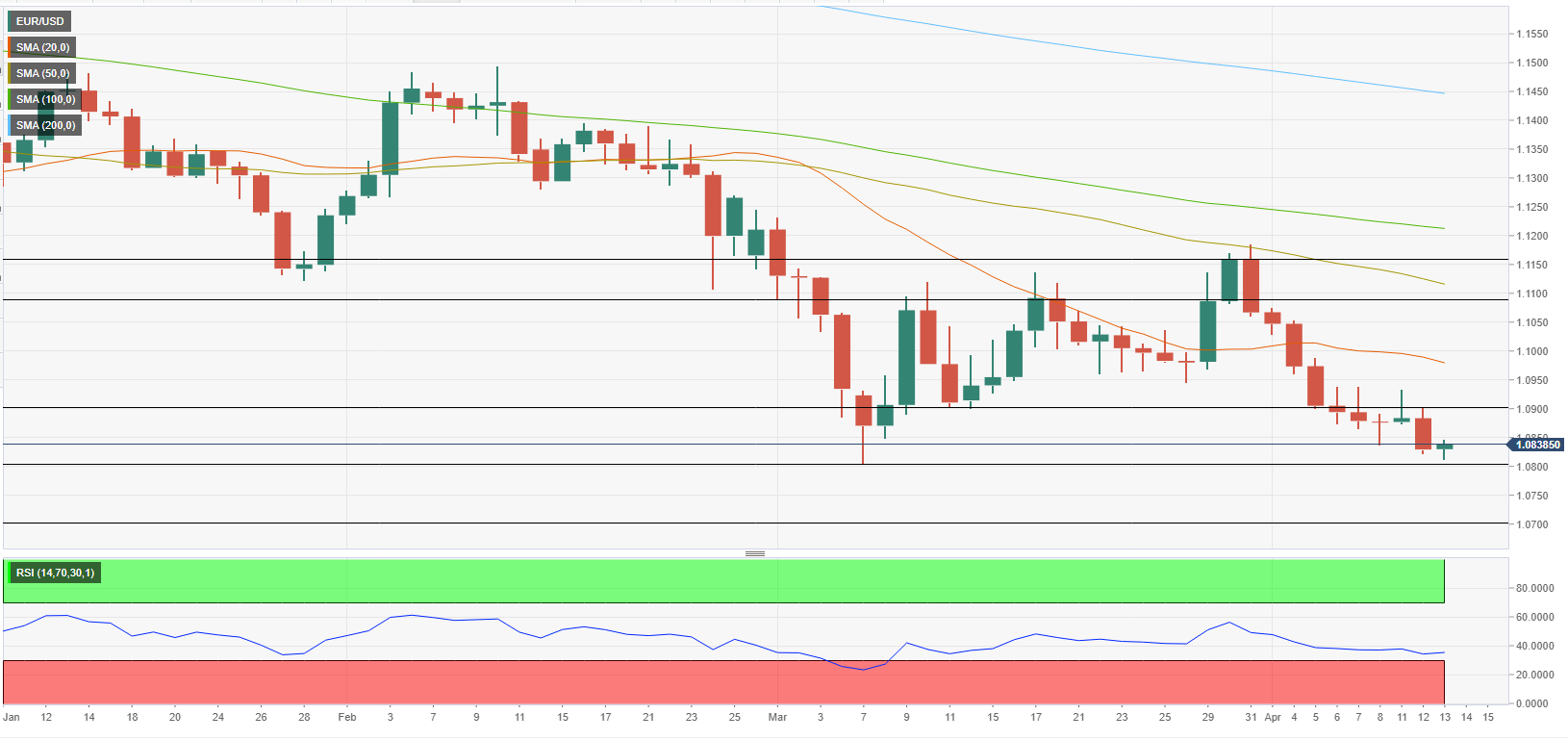- Euro has been struggling to find demand since the beginning of April.
- ECB is widely expected to leave key rates unchanged.
- A hawkish shift in ECB's policy outlook could trigger a steady rebound in EUR/USD.
EUR/USD is already down more than 2% in April amid the apparent policy divergence between the Federal Reserve and the European Central Bank (ECB). The European economy is widely expected to suffer heavier damage from a protracted conflict between Russia and Ukraine than the US economy, and the Fed remains on track to hike its policy rate by 50 basis points in May.
The shared currency needs the ECB to adopt a hawkish policy stance in order to stay resilient against the greenback.
In March, the ECB left interest rates on the marginal lending facility and the deposit facility unchanged at 0.00%, 0.25% and -0.50% respectively. The bank further announced that monthly net purchases under the Asset Purchase Programme (APP), which were initially planned to end in the fourth quarter, will amount to €40 billion in April, €30 billion in May and €20 billion in June before ending in the third quarter.
The accounts of the ECB’s March meeting revealed earlier in the month that a large number of the governing council members held the view that the current high level of inflation and its persistence called for immediate further steps towards monetary policy normalization.
Hawkish scenario
The ECB could decide to adjust the monthly purchases to open the door for a rate hike in the second half of the year if needed. The bank might keep the purchases under APP unchanged at €40 billion in April but bring them down to €20 billion in May to conclude the program by June. Even if the policy statement refrains from offering hints on the timing of the first rate increase, such an action could be seen as a sign pointing to a June hike.
In a less-hawkish stance, the bank may choose to leave the APP as it is but change the wording on the QE to say that it will be completed in June rather than in Q3. ECB President Christine Lagarde’s language on the timing of the rate hike will be key if the bank decides not to touch the APP. During the press conference in March, Lagarde noted that the rate hike would come “some time” after the end of QE. If Lagarde confirms that they will raise the policy rate right after they end the APP, this could also be seen as a hawkish change in forward guidance.
Dovish scenario
The ECB might downplay inflation concerns and choose to shift its focus to supporting the economy in the face of heightened uncertainty by leaving the policy settings and the language on the outlook unchanged.
The euro is likely to come under heavy selling pressure if the bank reiterates that the APP will end in the third quarter as planned. That would push the timing of the first rate hike toward September and put the ECB way behind the curve in comparison to other major central banks. According to the CME Group FedWatch, markets are pricing in a more-than-60% probability of back-to-back 50 bps hikes in May and June.
Conclusion
The ECB is likely to respond to the euro’s weakness, aggressive tightening prospects of major central banks and hot inflation in the euro area by turning hawkish in April. For EUR/USD to stage a steady rebound, however, the bank may have to convince markets that they are preparing to hike the policy rate by June.
On the other hand, there will be no reason to stop betting against the euro if the bank chooses to leave its policy settings and forward guidance unchanged.
EUR/USD technical outlook
EUR/USD closed the previous seven trading days below the 20-day SMA and the Relative Strength Index (RSI) indicator stays below 40, suggesting that bears continue to dominate the pair’s action.
On the downside, 1.0800 (psychological level, March low) aligns as first support. With a daily close below that level on a dovish ECB, EUR/USD could target 1.0700 (psychological level) and 1.0630 (March 2020 low).
Key resistance seems to have formed at 1.0900 (psychological level, static level). In case this level turns into support, a steady rebound toward 1.1000 (psychological level, 20-day SMA) and 1.1100 (static level, psychological level) could be witnessed.
Information on these pages contains forward-looking statements that involve risks and uncertainties. Markets and instruments profiled on this page are for informational purposes only and should not in any way come across as a recommendation to buy or sell in these assets. You should do your own thorough research before making any investment decisions. FXStreet does not in any way guarantee that this information is free from mistakes, errors, or material misstatements. It also does not guarantee that this information is of a timely nature. Investing in Open Markets involves a great deal of risk, including the loss of all or a portion of your investment, as well as emotional distress. All risks, losses and costs associated with investing, including total loss of principal, are your responsibility. The views and opinions expressed in this article are those of the authors and do not necessarily reflect the official policy or position of FXStreet nor its advertisers. The author will not be held responsible for information that is found at the end of links posted on this page.
If not otherwise explicitly mentioned in the body of the article, at the time of writing, the author has no position in any stock mentioned in this article and no business relationship with any company mentioned. The author has not received compensation for writing this article, other than from FXStreet.
FXStreet and the author do not provide personalized recommendations. The author makes no representations as to the accuracy, completeness, or suitability of this information. FXStreet and the author will not be liable for any errors, omissions or any losses, injuries or damages arising from this information and its display or use. Errors and omissions excepted.
The author and FXStreet are not registered investment advisors and nothing in this article is intended to be investment advice.
Recommended Content
Editors’ Picks

Gold falls amid a possible de-escalation of US-China tensions Premium
Gold pulled back from its all-time high of $3,500 per troy ounce reached earlier on Tuesday, as a resurgent US Dollar and signs of easing tensions in the US–China trade dispute appeared to draw sellers back into the market.

EUR/USD retreats to daily lows near 1.1440
EUR/USD loses the grip and retreats to the 1.1440 zone as the Greenback’s rebound now gathers extra steam, particulalry after some positive headlines pointing to mitigating trade concerns on the US-China front on Tuesday.

GBP/USD deflates to weekly lows near 1.3350
GBP/USD loses further momentum and recedes to the 1.3350 zone on Tuesday, or two-day troughs, all in response to the frmer tone in the US Dollar and encouraging news from the US-China trade scenario.

3% of Bitcoin supply in control of firms with BTC on balance sheets: The good, bad and ugly
Bitcoin disappointed traders with lackluster performance in 2025, hitting the $100,000 milestone and consolidating under the milestone thereafter. Bitcoin rallied past $88,000 early on Monday, the dominant token eyes the $90,000 level.

Five fundamentals for the week: Traders confront the trade war, important surveys, key Fed speech Premium
Will the US strike a trade deal with Japan? That would be positive progress. However, recent developments are not that positive, and there's only one certainty: headlines will dominate markets. Fresh US economic data is also of interest.

The Best brokers to trade EUR/USD
SPONSORED Discover the top brokers for trading EUR/USD in 2025. Our list features brokers with competitive spreads, fast execution, and powerful platforms. Whether you're a beginner or an expert, find the right partner to navigate the dynamic Forex market.
